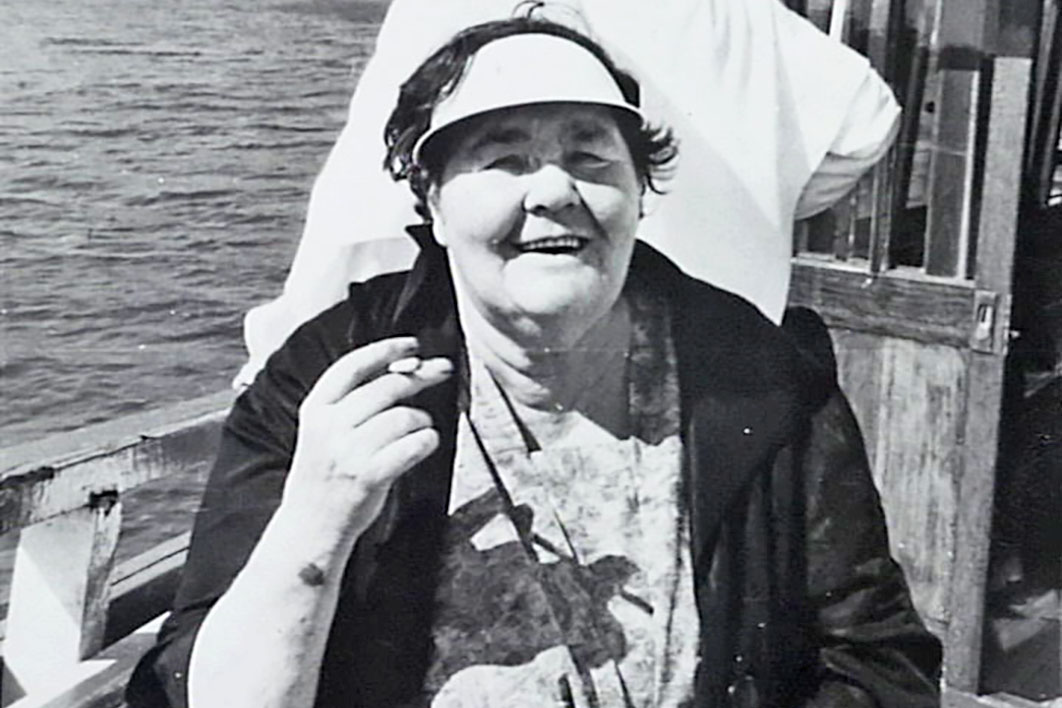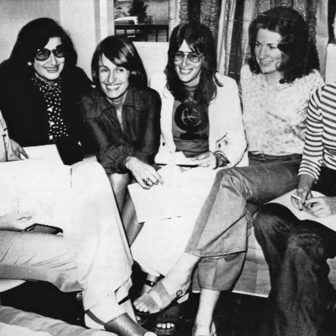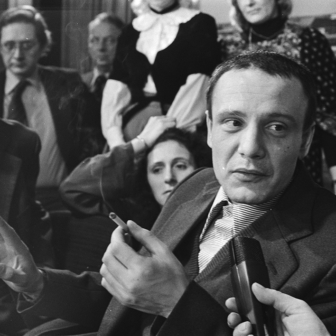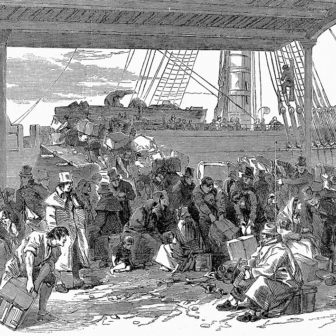Bee Miles first attracted notoriety when she made a sensational escape from Sydney’s Parramatta Mental Hospital in February 1927. She had spent the previous three years in various institutions for the mentally ill at the behest of her father, a wealthy businessman named William Miles.
Embarrassed by her escape, William decided to pay Bee a weekly allowance in the hope she would keep as far away from him and the family as possible. This she mostly did, but she was unable to curb her disruptive and sometimes violent public behaviour. She was constantly being arrested, charged and fined, and was jailed when she could not pay the fines; many times she was forced back into asylums. This was the pattern for almost the rest of the life of the woman widely known as a Sydney bohemian.
During and after the second world war Sydney’s acute housing shortage forced Bee to sleep rough. It is a common myth that she chose homelessness. “No one chooses to be homeless,” notes Rose Ellis, in Bee Miles, the first major biography of her subject. When Bee could no longer afford to rent a room but her allowance meant the city’s social services couldn’t help her, she declared herself a “tenant of the city.” Writes Ellis: Sydney’s “public heart became home, its streets and steps her bed.”
Bee would wake at 5am, hook her blankets to her belt and make her way from wherever she had been sleeping to Mason’s Café in Elizabeth Street, opposite Central Station. She breakfasted there on steak and eggs every morning for nearly twenty years. Afterwards she would go to Dobson’s Turkish Bathhouse where she was given a regular free timeslot to have a bath and wash her hair and clothes. The myth says that Bee was “dirty,” but it wasn’t so. She loved a long, hot bath.
Bee’s working day as a “roving reciter” (Ellis’s words) then began. Passing a delicatessen where she received a free bottle of milk and a barrow where she received a piece of fruit, she would catch a bus from Eddy Avenue to some destination, Watson’s Bay perhaps, where she would offer recitals of poetry and prose for money. Her rates varied from sixpence to three shillings, and Shakespeare was her favourite. To advertise this service she wore a sandwich board.
Back in the city she would perform through the afternoon at a regular spot, such as the steps at the Mitchell Library where there was a regular flow of students. She used to enjoy visits to its reading room until she was banned for smoking. She might end her day with a visit to a friend, not that she had many, or a bookshop or cinema. She dined at 5pm, always curried tongue and peas, and chose her place to sleep for the night, which could be a cave at Rushcutters Bay, under a shed in the Domain, on the steps of St James church opposite Hyde Park Barracks, or in the bandstand at Belmore Park.
After years of being moved on and jumped on, having her blankets and shoes kicked away, and sometimes even being urinated on by the police, Bee finally accepted refuge from Father John Hope (uncle of Manning Clark), rector of Christ Church St Laurence. She slept on the floor of the laundry in the clergy house.
Bee Miles was always on the move. She loved speed — and risk. As a young woman she became known as “mad Bee Miles” for jumping on and off moving trains on her way from the family home in Wahroonga to the University of Sydney. Her university career lasted only a year and it was said (another myth, of course) that her mind was “turned” by too much study.
She would cling to the bumper bars or footboards of cars, or climb right into a car or taxi and order the driver to drive on. She refused to pay on public transport and conductors learned that it was often wiser not to demand a fare, fearful of the scenes she could cause. Some of her most violent confrontations came when taxi drivers, judging her dishevelled appearance, refused to take her as a paying customer. She suffered several serious assaults this way, the driver-perpetrators never charged.
Prodigiously researched (it began as a PhD), Ellis’s life of Bee Miles unfolds elegantly, uninterrupted by personal perspectives or anecdotes of Ellis’s own. She shares nothing about the relationship she must have developed with her subject (surely every biographer has one). If she essayed a night sleeping in the bandstand in Belmore Park, she doesn’t say. She’s not that kind of biographer.
Her book begins serenely enough. We discover a small girl seated at a piano in a room with a vaulted ceiling and long stained-glass windows overlooking a sprawling garden. The girl is Beatrice Miles and she is practising under the careful but kindly gaze of her grandmother, Ellen Cordner-Miles, a celebrated contralto in Sydney in the 1870s. The afternoon light fades but the girl plays on in the otherwise silent house.
Ellen’s son William Miles, Bee’s father, had taken on various family business enterprises and of these Peapes & Co., a men’s clothing store in George Street, was the most successful. William and his wife Maria had five children. Bee (she insisted on “Bee” and not “Bea”) was born in 1902.
William was a man of contradictions, as famous for his business acumen as for his political radicalism. A devotee of the rationalist and free-thought movements, he raised his children as atheists and taught them the rationalist dictum to reject all forms of “arbitrary” authority. During the first world war he took to a speaker’s box on the Domain to rail against the proposed introduction of conscription, and he instructed his three daughters to wear “No” badges at their school, Abbotsleigh College. Bee relished the ensuing controversy, though her sisters did not.
William might have encouraged Bee’s agile mind but he didn’t expect her to reject his own authority. Her adolescent years were torrid. “Family friction is a battle fought daily,” Ellis observes. “Superficial wounds heal quickly in readiness for the next confrontation. But parental rejection leaves scars that are deep and enduring.”
Fifty years later Bee recalled that her father loved her until she reached the age of fourteen, after which he hated her, angered by her “wilful” nature and jealous of her superior intellect. And yet she also claimed that her mother became jealous of the close relationship between father and daughter, which was more than close, Bee said, it was incestuous. Bee believed that William feared that his wife would go to the police or tell a doctor.
Further trouble came when, at seventeen, Bee contracted encephalitis lethargica, known as “sleeping sickness.” She was with her mother buying gloves at Farmer’s department store one day when she fell asleep at the counter and could not be woken. She had fallen victim to a pandemic, brought to Australia by a returning Anzac, that caused 500,000 deaths in Europe and Australia.
Encephalitis lethargica mainly targeted young people, leaving survivors like Bee with lifelong side effects. Unusually, she escaped the Parkinsonism that afflicted other sufferers, but sensitivity to light (in later years she often wore a sunshade), obesity (she put on weight massively in her forties) and, most significantly, her exhibitionism and her addiction to movement: all were probably the after-effects of encephalitis lethargica.
Here then is the “untold story” of the title of this book, and an ah ha! moment for readers who have heard of or still remember Bee Miles. Ellis treats the subject of Bee’s illness very carefully. Early on she gives enough information about the disease and its effects for the reader to carry forward into the rest of the book because it explains so much about Bee.
But encephalitis lethargica was not the only thing to shape Bee. What with adolescent trauma and her own questing mind, she may never have settled for the life of a North Shore lady anyway. Ellis wants us to know about the joys and freedoms Bee experienced, as well as the pain and loneliness.
By the time she returns to Bee’s illness in the penultimate chapter of the book I was ready and eager to know more. Bee became ill in 1920 and nearly died. Ellis has worked through thirty-six years’ worth of Bee’s medical case notes and finds that although encephalitis lethargica was mentioned many times, specifically or in passing, her doctors condemned Bee through the lens of their own morality. She was “wilful,” “restless,” “impulsive,” “childish,” “arrogant,” “impudent” and “tearful.”
All of this, as well as her attention-seeking behaviour and love of speed and movement, was consistent with well-documented observations of post-encephalitis syndrome. But no one fully explored the link, even though the syndrome was being identified in Australian medical literature at the time. Doctors chose instead to believe her father, who may also have been her abuser, who claimed that Bee had always been “wilful” and lacked “respect for authority” — even though he himself had actively taught her to reject arbitrary authority.
Was Bee herself aware of the probable impact of her illness? Apparently so. In front of a magistrate in 1932 she shouted at her solicitor to “shut up” when he alluded to the effects of sleeping sickness. Many of us would find relief in a formal diagnosis (“at least I’m not actually mad”), but Bee never did. Refusing to be labelled, she rationalised her behaviour into her own view of herself.
She built this view through her public performances and the many press interviews she gave over four decades. She also wrote prolifically and longed to be published. Some of her short travelogues did appear in regional newspapers, but her longer work, including accounts of her incarceration in the 1920s and the massive journeys she made to northern Australia in the 1930s, never found a publisher. Ellis quotes Bee’s own words extensively, however, and thus ensures that she can be known on her own terms and not just as the construct of a male gaze captured in court records and medical case notes.
At sixty-two, after a life of fiercely resisting authority and convention, Bee finally accepted a place in a Catholic-run nursing home, where she died in 1973. A journalist for the Daily Telegraph who visited her in her cave near Rushcutters Bay in 1948 had listed Bee’s fifteen “rules for living.” They included avoiding covetousness, being content with what you have, singing when you are happy, sleeping when it’s dark, and living “toughly, dangerously, excitingly, exhilaratingly and simply.” •
Bee Miles: Australia’s Famous Bohemian Rebel, and the Untold Story Behind the Legend
By Rose Ellis | Allen & Unwin | $34.99 | 336 pages




